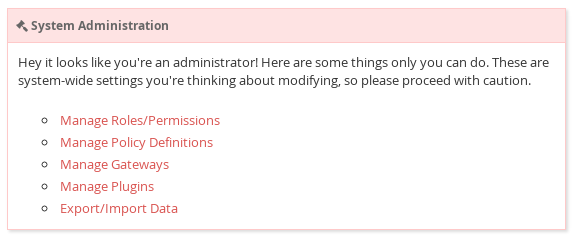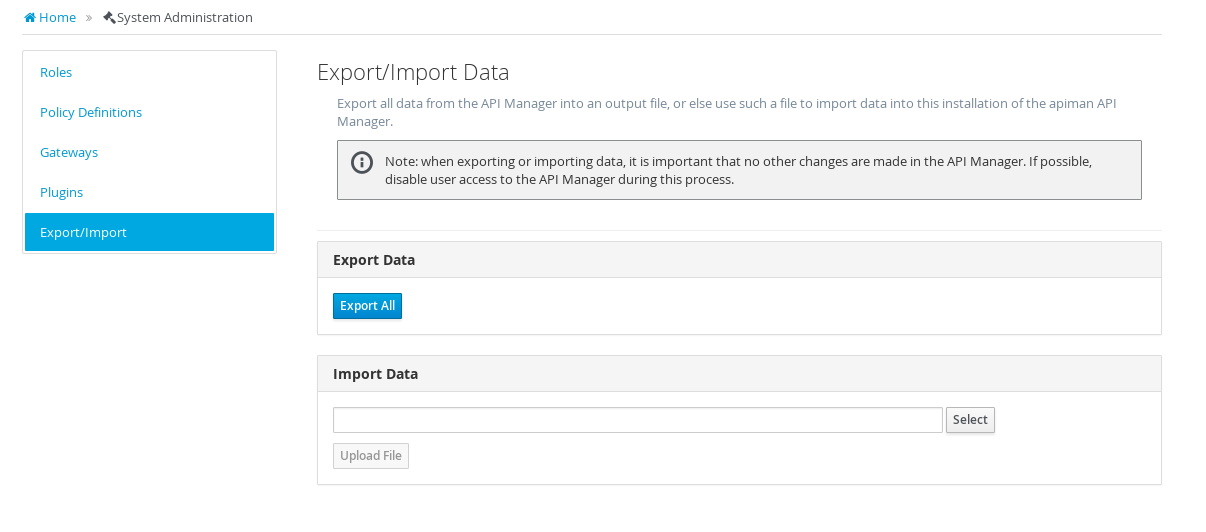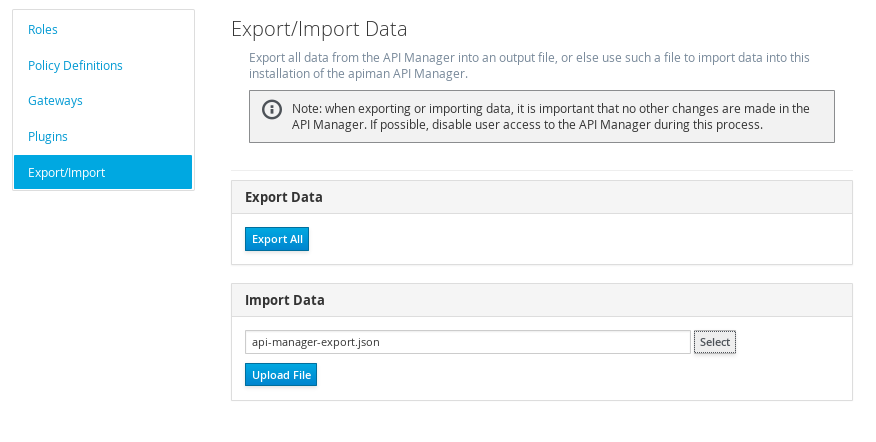The Question you Dread
If
you use a computer at home or at work, you'll eventually find yourself
in a situation where you lose some important data and, while you are
trying to recover it, someone asks you a question that is simultaneously
annoying and terrifying:
"Did you make a backup?"
Happily,
the 1.2 release of apiman includes a new feature that enables you to
export and import your apiman data and provides you with an easy means
to create apiman data backups. In this post, we'll take a look at the
new export/import feature, and how you can use it for a variety of tasks
to protect your data, make your life easier, and enable you to avoid
annoying and terrifying questions.
For test data, we'll
use the same types of data (organizations, users, plans, policies, APIs
and client apps), that we created in the initial post in this series. (
https://dzone.com/articles/impatient-new-users )
Note
that since that post was written in January 2015, some of the names of
the data elements have changed. You can either create the test data
referred to in this post yourself, or you can import the data file
attached to the post.
Export/Import in apiman 1.2.1
The
new export/import feature in apiman 1.2.1 enables you to export your
apiman configuration data to a file, which can later be imported into an
apiman system. Note that this feature follows an all-or-nothing
approach in that is does not support incremental backup and restore of
selected apiman data.
The three main use cases that the export/import feature supports are:
- Backing up all your apiman data
- Upgrading to a newer version of apiman
- Migrating apiman data from a Test environment to a Production environment
The
export/import operations are only available to Administrative users.
The export/import feature is accessed through the admin operations menu:

Once you select the Export/Import Data feature, this menu is displayed:

One
thing to keep in mind is that while you are importing or exporting
data, no changes to data should be made or else the export/import may
encounter an error, or may result in incomplete results. To be safe, you
should disable user access to the API Manager, both the Management UI
and its REST interface, for the duration of the import or export
operation.
We'll look at exporting data first.
Backing up apiman Data
To
make a backup of all your apiman data, simply select the "Export All"
button. The apiman data will be written to a file and downloaded by your
browser. Your browser's settings will determine where the file is
saved.
The apiman data is written to a file named: api-manager-export.json
As
its name indicates, the apiman data is written in JSON form. This
format provides us with several advantages. First of all, it's the
format in which apiman is able to import data. (We'll perform an import
later in this post.) Secondly, it's a text file where the contents of
the file are human readable. The content of the file is ALL the apiman
data, both the data elements that you have created and the data elements
with which apiman is preconfigured.
Reading this file
can greatly increase your understanding of the elements that are defined
in apiman. Let's take a look at the elements in the file:
- Users - The preconfigured "admin" user is defined here, as are the new users we create.
- Gateways - The preconfigured apiman Gateway is defined here.
- Roles - The preconfigured, permission-based roles, and new roles that we create, are defined here. For example, the "OrganizationOwner" role is shown to have these permissions: [ "apiAdmin", "orgAdmin", "apiView", "orgEdit", "clientEdit", "clientAdmin", "planView", "orgView", "planAdmin", "clientView", "planEdit", "apiEdit" ]
- Policy Definitions - Next, the preconfigured policies, and new policies that we create, are defined here. For example: the "RateLimitingPolicy" is described as "Enforces rate configurable request rate limits on an API. This ensures that consumers can't overload an API with too many requests."
- The remainder of the file includes the elements that we create: Organizations, Plans, APIs, and Client Apps. For example, here is the definition of the "echo" API that we created:
"Apis" : [ {
"ApiBean" : {
"id" : "echo",
"name" : "echo",
"description" : "The echo API",
"createdBy" : "serprov",
"createdOn" : 1453773184836,
"numPublished" : 1
},
"Versions" : [ {
"ApiVersionBean" : {
"id" : 10,
"status" : "Published",
"endpoint" : "http://localhost:8080/apiman-echo",
"endpointType" : "rest",
"endpointContentType" : "json",
"endpointProperties" : { },
"gateways" : [ {
"gatewayId" : "TheGateway"
} ],
"publicAPI" : false,
"plans" : [ {
"planId" : "gold",
"version" : "1.0"
} ],
"version" : "1.0",
"createdBy" : "serprov",
"createdOn" : 1453773184845,
"modifiedBy" : "serprov",
"modifiedOn" : 1453773312563,
"publishedOn" : 1453773327835
},
"Policies" : [ {
"id" : 14,
"type" : "Api",
"organizationId" : "ACMEServices",
"entityId" : "echo",
"entityVersion" : "1.0",
"name" : "BASIC Authentication Policy",
"configuration" : "{\"realm\":\"Echo\",\"requireBasicAuth\":false,\"staticIdentity\":{\"identities\":[{\"username\":\"user1\",\"password\":\"admin123!\"}]}}",
"createdBy" : "serprov",
"createdOn" : 1453773312553,
"modifiedBy" : "serprov",
"modifiedOn" : 1453773312553,
"definition" : {
"id" : "BASICAuthenticationPolicy",
"templates" : [ ],
"deleted" : false
},
"orderIndex" : 1
} ]
One
thing to remember is that the exported data file represents ALL apiman
data. It's not yet possible to perform incremental data backups in
apiman. If you attempt to import the data from this file into the same
apiman installation from which it was generated, you will see unique
primary key violations as the import operation will attempt to create
duplicate data elements.
OK, now that we have this exported data file, what can we do with it?
Well,
obviously, if something goes wrong with your installation of apiman,
you can start over with a clean installation, and instead of manually
recreating your data, you can import the data. (Personal note from the
author: I work in software test/QE. Part of our testing is always
destructive in nature. As a result, we are always "messing up" test
data. The export/import feature enables us to quickly reinstall apiman
and recover a clean test environment.) To perform the import after a new
installation of apiman, you simply select and upload the exported data
file:

The Management UI displays the status of the import as the data is processed:

How else can we use the exported data file?
Upgrading to a Newer Version of apiman
One
of the best aspects of open source projects is the rapid rate at which
new features are implemented and new versions are released. It's
exciting to watch projects quickly mature as features are added and bugs
are fixed, and since the projects are open source, you can even make
your own contributions. This has been the case with apiman over the past
several months. New features have been added such as metrics and
support for creating custom policies.
One downside to
all the rapid change is that as new versions of apiman have been
released, we've had to recreate all our apiman data as there was no way
to migrate apiman data from one release to the next. The export/import
feature now gives us a way to export apiman data from one apiman release
and import it into a new apiman release.
NOTE: In cases
where the apiman data model changes between versions, apiman will
introduce tools to transform the JSON export file from an older format
to the latest. It has not yet been decided whether those tools will be
built into the Import process, or released as a standalone utility.
Migrating apiman Data from a Test Environment to a Production Environment
It's a common practice for organizations to maintain two separate installations of software releases:
- A test environment, where the goal is to experiment with new features. This is typically an internal environment that gives up some measure of stability in exchange for the ability to "try out" new features as they become available. The rate of change for this environment is high as any disruption in service in this environment do not affect customers.
- A production environment, where the goal is stability. This is the environment that supports your customers. Changes happen slowly in this environment and new features are only installed after they are carefully tested as disruptions in service in this environment do affect customers.
The new export/import feature in
apiman 1.2 makes it possible for you to experiment with changes in your
test environment, and, after the changes have been found to be stable,
to easily migrate your test data from the test environment into your
production environment. (You will, of course, create a backup of your
production environment data before making any changes. ;-)
Migrating apiman from one storage solution to another
Finally,
when apiman is first installed, you must make various decisions about
its configuration. One of these decisions is where to store
configuration and data. When you first install apiman, you might decide
that MySQL is the right choice. However, somewhere along the line you
might change your mind - perhaps you want to switch to postgresql, or
even more drastically you might switch to Elasticsearch! The
Export/Import process described here solves the problem of how to
migrate all your data from one storage location to another.
The
process is basically the same as upgrading to a newer version of
apiman. But instead you will be upgrading to the same version of
apiman, but with a different configuration. Because the exported data
is in a neutral (JSON) format, we can easily import into the new
configuration. This will result in all your data being migrated from
MySQL to Elasticsearch (for example).
In Conclusion
The
new export/import feature in apiman 1.2 provides an easy way to
safeguard your apiman data and to make it possible to migrate your data
between apiman releases and installations. In addition, since the
exported data is human readable, it is a great resource for better
understanding apiman data structures. And, it's easy to use too!
Cross-posted to: